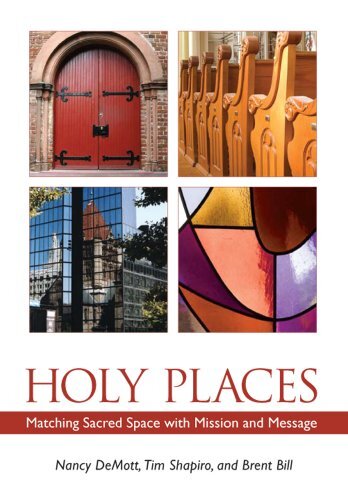Nancy Demott, Tim Shapiro, and Brent Bill, Holy Places: Matching Sacred Space With Mission and Message. Alban Institute, 2007.
Note: This listing is part of the site archive. While these materials may have some enduring value, it is strongly suggested that you use the reference link below for possible updates or click through to Amazon and allow their settings to suggest more current resources.
Referenced in: Church Administration – Architecture and Building Issues
LifeandLeadership.com Summary
Any church engaging a building project needs to consult several resources, but Holy Places is a primary tool. It is a thorough, start-to-finish guidebook designed for use by church building task forces. Each chapter is well-written and understandable, with summary lists and project-related reflection questions at the end. It also includes extensive appendices, check-lists, and an annotated resource guide.
A strength of Holy Places is that it goes beyond bricks-and-mortar and tape measures, but addresses how foundational issues such as a congregation’s corporate culture – faith, identity, mission, constituency, demographics – should shape the building project. It is not prescriptive on what the mission of a congregation should be, but lays out healthy group processes to help congregations reflect on this for themselves. The authors propose this as the first phase of the building process, Discern.
From this foundation, Holy Places walks readers through the two remaining phases of building, Decide and Do. The second stage, Decide, looks at the four facets of aesthetics, finances, project delivery, and resources. It is especially good in helping those involved interact with the various professionals involved in a building project (capital stewardship consultants, architects, contractors, engineers, etc.).
The third stage, Do, equips a church for three more aspects of building projects: communications, spirituality, and oversight. This is another strength of the book which discusses how to lead the people of the congregation through a building project as a faith enterprise. It addresses such issues as keeping members up-to-date and involved, integrating the building project into the ongoing life of the congregation (e.g. adjusting to temporary structures), and assuring them of the proper management of the time-line, capital resources, etc.
From the Publisher
Buildings communicate. Stained glass windows, high altars, multi-purpose worship/gymnasium spaces, Plexiglas pulpits, padded pews – these and all other architectural elements say something about a congregation’s theology and mission. They point to a faith community’s beliefs about worship, identity, purpose, and more. From the stark simplicity of a Quaker meetinghouse to the splendor of a Romanesque Revival building, sacred spaces speak loudly. What they say can either reinforce a congregation’s mission or detract from it.
Holy Places is designed to be used by congregations who are involved in or are contemplating work on their facilities. This could include renovation, remodeling, expansion, or building. No matter how extensive the project, approaching the work with mission at the forefront is the key to having a final result that strengthens the congregation’s ministry.
Intended for leaders in a congregation’s facility project – from expert builders to novices – this book will help you create a reflective approach to your work, enable you to learn from one another, and make space for discerning God’s direction for your congregation. Each phase of the process – discern, decide, and do – consists of a series of questions that a congregation must address and assumes no particular level of prior knowledge about building issues. This effective process lets congregations begin where they are and provides the help they need to move to the next level.
Editorial Reviews
Holy Places coaches you in the art of good communication by enhancing your discernment and decision-making skills. This book provides you with insight to help take advantage of one of your greatest resources: opportunity. — Keith Crouch, AIA, NCARB, Church Architecture Resources
Holy Places outlines each step of the building process, so your congregation can have confidence in the outcome—a completed project that matches your mission. — Cynthia Woolever, Sociologist, U.S. Congregational Life Project
Have every member of your congregation read Holy Places; it offers a clear and compelling guide to rethinking—not just rebuilding—your sacred place. — Ron Wolfson, Author, The Spirituality of Welcoming: How to Transform Your Congregation into a Sacred Community, President, Synagogue 3000
About the Authors
Nancy DeMott is an American Baptist Christian educator and pastor and is resource director for the Indianapolis Center for Congregations in Indianapolis, Indiana.
Tim Shapiro is a Presbyterian pastor and is president of the Indianapolis Center.
Brent Bill is a minister in the Religious Society of Friends (Quakers) and is the Indianapolis Center’s executive vice president.
***For additional information on this resource, including reviews, click the bookstore links. Check the reference at page top or the links below for resource guides on related topics.***
See Resources on Over 100 Areas of Ministry Leadership:


